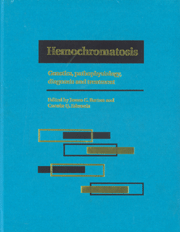Book contents
- Frontmatter
- Contents
- List of contributors
- Foreword
- Part I Introduction to hemochromatosis
- Part II Genetics of hemochromatosis
- Part III Metal absorption and metabolism in hemochromatosis
- Part IV Diagnostic techniques for iron overload
- Part V Complications of iron overload
- Part VI Therapy of hemochromatosis and iron overload
- Part VII Infections and immunity in hemochromatosis
- 35 Role of iron in infections and immunity
- 36 Bacterial infections in hemochromatosis
- 37 Chronic viral hepatitis and hemochromatosis
- 38 T-lymphocyte expression and function in hemochromatosis
- Part VIII Hemochromatosis heterozygotes
- Part IX Relationship of hemochromatosis to other disorders
- Part X Animal models of hemochromatosis and iron overload
- Part XI Screening for hemochromatosis
- Part XII Hemochromatosis: societal and ethical issues
- Part XIII Final issues
- Index
36 - Bacterial infections in hemochromatosis
from Part VII - Infections and immunity in hemochromatosis
Published online by Cambridge University Press: 05 August 2011
- Frontmatter
- Contents
- List of contributors
- Foreword
- Part I Introduction to hemochromatosis
- Part II Genetics of hemochromatosis
- Part III Metal absorption and metabolism in hemochromatosis
- Part IV Diagnostic techniques for iron overload
- Part V Complications of iron overload
- Part VI Therapy of hemochromatosis and iron overload
- Part VII Infections and immunity in hemochromatosis
- 35 Role of iron in infections and immunity
- 36 Bacterial infections in hemochromatosis
- 37 Chronic viral hepatitis and hemochromatosis
- 38 T-lymphocyte expression and function in hemochromatosis
- Part VIII Hemochromatosis heterozygotes
- Part IX Relationship of hemochromatosis to other disorders
- Part X Animal models of hemochromatosis and iron overload
- Part XI Screening for hemochromatosis
- Part XII Hemochromatosis: societal and ethical issues
- Part XIII Final issues
- Index
Summary
Introduction
The availability of iron for pathogenic organisms plays a critical role in infection. In normal tissue, iron is not readily available because plasma and other tissue fluids contain unsaturated iron-binding proteins. These are transferrin in plasma and lymph, and lactoferrin in external secretions such as milk and mucous. These proteins ensure that the concentration of free iron in these fluids is virtually zero. This is essential for the bactericidal and bacteriostatic properties of plasma and other tissue fluids, and has a marked influence on overall resistance to infection.
Hemochromatosis is one of many disorders in which susceptibility to bacterial infection is increased by the presence of freely available iron, and this may occur for a number of reasons. Iron overload that develops in many persons with hemochromatosis is one reason. Other sources of freely available iron include iron from hemoglobin freed by the lysis of erythrocytes, and iron released from traumatised tissue. Each of these circumstances leads to the same result: iron-replete bacteria are no longer susceptible to the bactericidal or bacteriostatic mechanisms present in tissue fluids. This allows rapid extracellular bacterial growth with a great increase in bacterial virulence.
The importance of iron-binding proteins
The iron-binding protein transferrin present in normal human plasma and lymph is ∼30% saturated with ferric iron. Its high association constant for Fe3+ (∼1036) ensures that the concentration of free ferric iron in tissue fluids is ∼10−18 M, which may be regarded as virtually zero.
- Type
- Chapter
- Information
- HemochromatosisGenetics, Pathophysiology, Diagnosis and Treatment, pp. 381 - 386Publisher: Cambridge University PressPrint publication year: 2000
- 5
- Cited by



